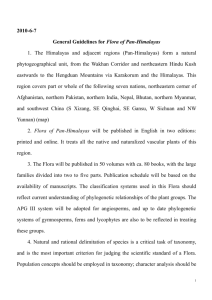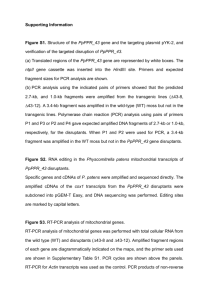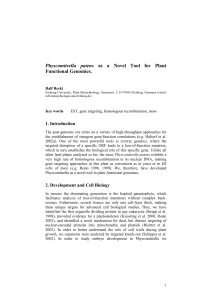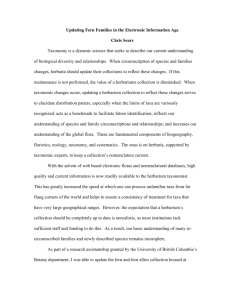THAISZIA Taxonomy and phylogeny of Anemone patens L. sensu
advertisement
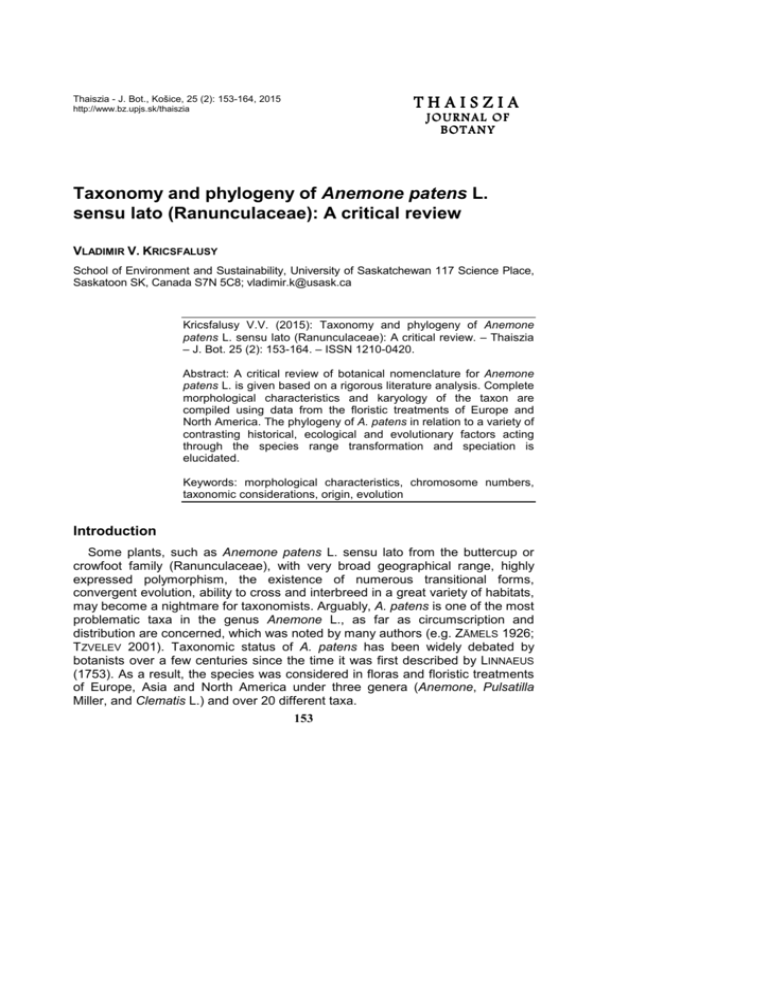
Thaiszia - J. Bot., Košice, 25 (2): 153-164, 2015 http://www.bz.upjs.sk/thaiszia THAISZIA JOURNAL OF BOTANY Taxonomy and phylogeny of Anemone patens L. sensu lato (Ranunculaceae): A critical review VLADIMIR V. KRICSFALUSY School of Environment and Sustainability, University of Saskatchewan 117 Science Place, Saskatoon SK, Canada S7N 5C8; vladimir.k@usask.ca Kricsfalusy V.V. (2015): Taxonomy and phylogeny of Anemone patens L. sensu lato (Ranunculaceae): A critical review. – Thaiszia – J. Bot. 25 (2): 153-164. – ISSN 1210-0420. Abstract: A critical review of botanical nomenclature for Anemone patens L. is given based on a rigorous literature analysis. Complete morphological characteristics and karyology of the taxon are compiled using data from the floristic treatments of Europe and North America. The phylogeny of A. patens in relation to a variety of contrasting historical, ecological and evolutionary factors acting through the species range transformation and speciation is elucidated. Keywords: morphological characteristics, chromosome numbers, taxonomic considerations, origin, evolution Introduction Some plants, such as Anemone patens L. sensu lato from the buttercup or crowfoot family (Ranunculaceae), with very broad geographical range, highly expressed polymorphism, the existence of numerous transitional forms, convergent evolution, ability to cross and interbreed in a great variety of habitats, may become a nightmare for taxonomists. Arguably, A. patens is one of the most problematic taxa in the genus Anemone L., as far as circumscription and distribution are concerned, which was noted by many authors (e.g. ZÄMELS 1926; TZVELEV 2001). Taxonomic status of A. patens has been widely debated by botanists over a few centuries since the time it was first described by LINNAEUS (1753). As a result, the species was considered in floras and floristic treatments of Europe, Asia and North America under three genera (Anemone, Pulsatilla Miller, and Clematis L.) and over 20 different taxa. 153 A. patens is a perennial herb widespread through the temperate regions of the Northern Hemisphere, comprising different intraspecific taxa. It ranges from Europe to North America, passing through Central, North and Eastern Europe as well as Central and North Asia, and reaching the central part of North America covering a wide range of climatic and habitat conditions. The distribution of A. patens across many countries and scientific traditions additionally contributes to the taxonomic confusion regarding this species. Moreover, no critical review has ever been published for this species. Therefore, main goals of this paper on A. patens are to: 1) compile morphological characteristics of the taxa based on the floristic treatments of Europe and North America, 2) conduct analysis of botanical nomenclature to review the species taxonomic status, and 3) elucidate the species origin and farther evolution in different parts of its range. Morphological characteristics This description of A. patens (Fig. 1) has been elaborated from published literature using both Flora Europaea (TUTİN & AKEROYD 1993) and Flora of North America (DUTTON et al. 1997). Habit: perennial herb, silky–villose throughout, with erect (or spreading) aerial shoots 5–40(–60) cm tall and 5–10 mm wide, growing from many–headed vertical caudices. Only fibrous roots present. Basal leaves: redundant in a rosette (3–)5–8(–10), erect, alternate, 3-foliolate with each leaflet dissected dichotomously. Stipules absent. Petiole present 5–10(–13) cm long with hairs longer than the diameter of the petiole. Terminal leaflet petiolulate to nearly sessile, obovate in outline, (2.5–)3–5 cm long. Leaflets spreading, straight, veins palmate. Margins dichotomously dissected throughout, apex acute to obtuse; lateral leaflets 3–4–parted (±dichotomously); ultimate segments 2–4 mm wide. Base narrowly cuneate. Surfaces villous, hairs white or translucent, simple or stellate, straight, spreading or erect; moderately dense on the abaxial surface, sparse on the adaxial surface. Inflorescences: flowering stems clearly taller than the leaves; with leaves. Solitary flowers with a villous or glabrate peduncle; involucral bracts present, 3, 1–tiered, simple, different from basal leaves, (2–)2.5–4 cm long, bases clasping, connate, margins deeply laciniate throughout; segments usually 4–6, filiform to linear, unlobed, 1–2(–3) mm wide. Surfaces villous, rarely glabrous. Flowers: large, 5.5–8.5 cm in diameter, campanulate. Epicalyx absent. Conventional sepals, 5–8, free, oblong to elliptic, coloured in blue, purple or rarely near white. Villous on the abaxial surface, glabrous on the adaxial one. Petals present. Stamens 150–200. Stamen filament glabrous. Anthers yellow; long–cylindrical; (0.8–)1.1–1.3(–1.8) mm long. Nectaries present. Ovary carpels 30–45; apocarpous. Ovaries densely hairy. One stigma per ovary, one ovule per ovary. Fruits: heads of achenes spheric to ovoid; pedicel 10–18(–22) cm long. Achenes body ellipsoid to obovoid, 3–4(–6) × ca. 1 mm long; dry, brown, not winged, villous; beak curved, 20–40 mm long, long–villous, plumose, indehiscent. One seed per achene. Styles modified and persisting in fruit; remaining straight. 154 Fig. 1. Anemone patens in the vicinity of Saskatoon, Canada (photo V. Kricsfalusy) Chromosome numbers Study by HOOT et al. (1994) demonstrated that the chromosome base-number of the majority species of Anemone and Pulsatilla is n = 8. The karyotype of Anemone species consists of five metacentric, one submetacentric, and two satellite subtelocentric chromosomes (PUNINA & GRIF 1984). A. patens is listed in the recent floristic compendia (TUTIN & AKEROYD 1993; DUTTON et al. 1997) and IPCN Chromosome Reports (2015) as diploid (2n = 16) in Europe, Asia and North America. However, the earlier study of this taxon (LÖVE 1954a) identified North American populations to be tetraploid (2n = 32) in contrast to diploid European and Asian populations (AGAPOVA et al. 1993; W EBER 2003). The more recent chromosome counts made on material from provinces of Alberta (TAYLOR & BROCKMAN 1966) and Manitoba (LÖVE 1982) in Canada identified A. patens as diploid (2n = 16). It seems that additional cytotaxonomic studies would be beneficial as they may shed light on evolutionary history of A. patens as well as give satisfactory explanation as to the species broad dispersal and high morphological variation. It is well known that the number of polyploid plants in floras of different regions of the world increases with extreme environmental conditions (STEBBINS 1985). 155 The direct influence between environment and polyploid plants has been long established (see review by STEBBINS 1950). Their great adaptability and ecological plasticity in different environmental conditions may be caused by large genetic variation obtained during hybridization (LEVIN 2002). According to LÖVE (1954b), a taxon which has been unable to disperse to new areas or penetrate into new edaphic and climatic conditions may give rise to a polyploid which can do so. By an alteration in chromosome constitution, polyploid species acquired higher tolerances enabling them to penetrate into new areas and then easily expand to the wide range of biotopes (LEVIN 2002). As suggested by SAUER (1988), introgression and allopolyploid speciation show some sort of interplay between the processes of migration and evolution. This might be the possible scenario for spread and further evolution of A. patens in North American part of its range. Taxonomic considerations A. patens is commonly known under several names in different parts of the world, such as prairie crocus and eastern pasqueflower, being the most often in North America and respectively in Europe. Other descriptive common names applied to this species include: prairie smoke, prairie pasqueflower, American pasqueflower, European pasqueflower, sticky pasqueflower, pulsatille, crocus anemone, cutleaf anemone, gosling plant, lionsbeard, wild crocus, windflower, etc. It is interesting that the major common name in North America, the prairie crocus, is incorrect and misleading from a scientific point of view. It was given to this plant by the European settlers that colonized the American prairies, as it reminded them of the true crocus of Europe, which in fact belongs to the genus Crocus L. in the iris family (Iridaceae). This species has been widely debated (Tab. 1) since the time it was first described by LINNAEUS (1753) from a specimen collected in Tobolsk, Siberia, in the former Russian Empire. Shortly after that, MILLER (1768) classified this species as Pulsatilla patens (L.) Mill., expressly distinguishing it from the genus Anemone. Later, specimens of this species collected in different parts of Europe and Asia were described under the names A. longipetala Schleich. ex Steud. (STEUDEL 1821), A. wolfgangiana Besser (BESSER 1826), A. intermedia G. Don (DON 1831), P. angustifolia Turcz. and P. latifolia Ruprecht (RUPRECHT 1854). Due to the work of TRAUTVETTER & MEYER (1856) the Siberian populations were classified as P. patens var. wolfgangiana (Besser) Trautv. & C.A. Mey. The name P. latifolia was applied by RUPRECHT (1854) to specimens of P. halleri (All.) Willd. ssp. rhodopaea (Stoj. & Stef.) K. Krause, as it is currently known (ref. to TUTIN & AKEROYD 1993). Recently, P. latifolia has been excluded from the taxonomic treatments as an illegitimate synonym (THE PLANT LIST 2013). Given a wide geographical range of the species and it having extensive morphological variation, several taxa were described in Europe and Asia which led to difficulties in their ranks and synonomies. For example, P. teklae Zämelis (ZÄMELIS 1926), initially recognized in the first edition of Flora Europaea (TUTIN 1964), currently is considered to be synonym of P. patens ssp. patens in the 156 second edition of Flora Europaea (TUTIN & AKEROYD 1993). Some names, for example, P. patens ssp. asiatica Krylov & Serg. (KRYLOV 1936) and P. kiovensis Wissjul. (W ISSJULINA 1939), or others are not infrequent in the East European botanical tradition (e.g. MOSYAKIN & FEDORONCHUK 1999; TZVELEV 2001; CZEREPANOV 2007), but are rarely used in the West European floristic practice (TUTIN 1964; TUTIN & AKEROYD 1993). Tab. 1. Accepted scientific nomenclature of Anemone patens. Europe and Asia North America A. patens L. LINNAEUS 1753 P. patens (L.) Mill. A. longipetala Schleich. ex Steud. A. wolfgangiana Besser A. intermedia G. Don MILLER 1768 STEUDEL 1821 P. angustifolia Turcz. TURCHANINOV 1840 Clematis hirsutissima Pursh A. ludoviciana Nuttall A. nuttalliana DC. BESSER 1826 DON 1831 A. patens var. multifida Pritz. PRITZEL 1841 P. wolfgangiana (Besser) Ruprecht P. latifolia Ruprecht RUPRECHT 1854 P. patens var. wolfgangiana (Besser) Trautv. & C.A. Mey A. patens var. wolfgangiana (Bess.) Koch A. taroi (Makino) Takeda P. patens ssp. multifida (Pritz.) Zämelis P. patens ssp. latifolia (Rupr.) Zämelis P. patens ssp. uralensis Zämelis P. patens ssp. teklae (Zämelis) Zämelis P. patens ssp. flavescens (Zucc.) Zämelis P. patens ssp. asiatica Krylov & Serg. P. flavescens (Zucc.) Juz. P. multifida (Pritz.) Juz. P. kioviensis Wissjul. P. patens (L.) Mill. var. kioviensis (Wissjul.) Tzvelev P. patens var. multifida (Pritz.) S.H. Li & Y.Hui Huang TRAUTVETTER & MEYER 1856 KOCH 1860 RUPRECHT 1854 TAKEDA 1910 ZÄMELIS 1926 A. nuttallii (DC.) Nuttall A. patens var. nuttalliana (DC.) A.Gray P. hirsutissima (Pursh) Britton A. hirsutissima (Pursh) MacMillan A. patens var. hirsutissima (Britton) Hitch. P. ludoviciana (Nuttall) Heller A. patens ssp. multifida (Pritz.) Hultén A. patens var. multifida Pritz. -“-“- ZÄMELIS 1926 -“- ZÄMELIS 1926 ZÄMELIS 1926 ZÄMELIS 1926 KRYLOV 1936 YUZEPCHUK1937 YUZEPCHUK1937 W ISSJULINA 1939 TZVELEV 2001 W ANG ET AL. 2001 157 PURSH 1814 NUTTALL 1818 CANDOLE DE 1817 NUTTALL 1825 GRAY 1867 BRITTON 1891 MACMILLAN 1892 HITCHCOCK 1892 HELLER 1904 HULTÉN 1944 GLEASON & CRONQUIST 1991 DUTTON ET AL. 1997 KARTESZ & MEACHAM 2005 VASCAN 2012 There are a series of species, such as P. wolfgangiana and P. kiovensis, as well as several intraspecific taxa and hybrids described from Ukraine during the th th 19 and 20 centuries (W ISSJULINA 1939, 1953). Their taxonomic value is dubious, and at present it is much more realistic to treat P. patens in a broad sense. However, TZVELEV (2001) in Flora of the Eastern Europe considered P. patens var. kiovensis (Wissjul.) Tzvelev as legitimate taxon. The Russian (Siberian) populations of P. patens were also often identified as separate taxa at the species or intraspecific levels. Nonetheless, all these taxa nowadays are considered to be synonyms of P. patens (Tab. 1). On the Far East, A. taroi Takeda was used as a synonym for A. patens (TAKEDA 1910). In terms of intraspecific taxonomy, ZÄMELIS (1926) on the basis of the number and width of the leaf lobes, length of the petiolule’s central segment, as well as flower colour divides P. patens into five subspecies: P. patens ssp. teklae (Zämelis) Zämelis and P. patens ssp. latifolia (Rupr.) Zämelis in Europe; P. patens ssp. uralensis Zämelis in Ural; P. patens ssp. flavescens (Zucc.) Zämelis, and P. patens ssp. multifida (G. Pritz.) Zämelis in Siberia. Later, however, several authors described individual subspecies of P. patens as separate species. Thus, YUZEPCHUK (1937) distinguished three species: P. patens sensu stricto in Europe; P. multifida (G. Pritz.) Juz. and P. flavescens (Zucc.) Juz. in Siberia. In his opinion, the latter species includes P. angustifolia Turcz. as a local race. According to YUZEPCHUK (1937), the main diagnostic features to distinguish these species are the flower colour, number and width of the leaf segments. It should be noted that most authors (KRYLOV 1931; POPOV 1957; SERGIEVSKAJA 1964; PAVLOVA 1990), in floristic treatments of the flora of Siberia, consider the distinguishing of separate species unreasonable and perceive P. patens s.l., as a single species comprising a large number of intraspecific taxa. The system, proposed by AICHELLE & SCHWEGLER (1957), generally was very similar to the previous one (YUZEPCHUK 1937) and repeated the same species. In subsequent studies, the trend toward separation of intraspecific taxa to the rank of species was consistent. Thus, ZIMMERMANN & MIEHLICH-VOGEL (1962) divided P. multifida и P. fiavescens into two separate species each. Therefore, the authors suggested system that consists of five species with particular geographic centres: P. patens s.str. in East Europe; P. fiavescens in Siberia; P. angustifolia in East Siberia; P. multifida in East and South Siberia; and P. nuttaliana (DC) Bercht. et Presl. in North America. The efforts to prepare treatment of A. patens for North American flora resulted in numerous nomenclatural changes, including description of new species and varieties (Tab. 1). Initially, PURSH (1814) identified this species as Clematis hisrsutissima Pursh from a specimen collected by LEWIS & CLARK during their western expedition. Shortly afterwards, NUTTALL (1818) transferred C. hirsutissima to the genus Anemone as A. ludoviciana NUTTALL & DE CANDOLE (1817) reclassified it under the name A. nuttalliana DC. Shortly after that, NUTTALL (1825) restore his priority as A. nuttalliana (DC.) Nuttall. Later, BRITTON (1891) and MACMILLAN (1892) reconsidered C. hirsutissima as P. hirsutissima 158 (Pursh) Britton and A. hirsutissima (Pursh) MacMillan respectively. Some other nomenclatural combinations developed over this period of time are now considered illegitimate or superfluous, e.g. P. nuttalliana (DC.) Sprengel (THE PLANT LIST 2013). th During the second half of the 19 century, botanists noticed the similarity of the taxa described in North America with A. patens known from the Old World and classified them as its varieties; e.g. A. patens var. nuttalliana (DC.) A. Gray (GRAY 1867) or A. patens var. hirsutissima (Britton) Hitch. (HITCHCOCK 1892). th This treatment gain more importance during the 20 century, and after the works of HULTÉN (1944), who identified the American populations as A. patens ssp. multifida (Pritz.) Hultén, there was little doubt about the Old and New World plants being the same taxon (e.g., HITCHCOCK et al. 1964; HITCHCOCK & CRONQUIST 1973). Most recent treatments of North American flora (e.g. GLEASON & CRONQUIST 1991; DUTTON et al. 1997; KARTESZ & MEACHAM 2005; VASCAN 2012) consider this taxon as. A. patens var. multifida Pritz (Tab. 1). Based on the history of A. patens classification reviewed above, a major difference between the aforementioned botanical approaches can be recognised. While the vast majority of the taxonomic treatments of the flora of Europe and Asia include this taxon under the genus Pulsatilla, most American authors prefer to place it in the genus Anemone. However, there still remains some controversy over the taxonomic status of A. patens per se. These controversial circumscriptions of the genera Anemone and Pulsatilla are present in more recent classifications as well. While some authors consider Pulsatilla to be a separate genus based mainly on morphological criteria (STARODUBTSEV 1991; TAMURA, 1995; ZIMAN et al. 2008), others argue that Pulsatilla should be subsumed within the Anemone, given recent molecular studies (e.g. HOOT et al. 1994, 2012; EHRENDORFER & SAMUEL 2001). In contrast, YARPAK (2011) considers the mentioned molecular studies to be too limited with an underrepresented number of taxa being considered. The author argues that morphological differences are clear, well known and based on a long botanical tradition, justifying priority choice for the genus Pulsatilla. In any case, it should be noted that this discussion turns around the phylogeny and evolution of the genera Anemone and Pulsatilla rather than taxonomic status of A. patens. As mentioned before, intraspecific composition of the study taxon is also complicated. According to TUTIN & AKEROYD (1993), it includes three subspecies: P. patens ssp. patens, P. patens ssp. multifida and P. patens ssp. flavescence. PRITZEL (1841) coined the name A. patens var. multifida for the first time, using it to designate the Siberian populations. This name has priority over the commonly used A. patens var. wolfgangiana (KOCH 1860). It was not until the beginning of th the 20 century when ZÄMELIS (1926) reclassified A. patens var. multifida as P. patens subsp. multifida. Later, JUZEPCZUK (1937) went beyond and considered P. multifida as a separate species. According to the author, P. multifida could be distinguished from P. patens by the strongly dissected leaf blades, narrower leaf segments and a distinct petiole. JUZEPCZUK’s (1937) view was criticized by other authors who could not see a real difference between the Siberian and the North 159 American populations, and these authors suggested they should therefore be referred to as the same subspecies (HULTÉN 1944). It has been suggested that the observed differences were the consequence of differentiating geographic races (subspecies) within a continuous range of P. patens across the northern hemisphere (HULTÉN & FRIES 1986; LINDELL 2001). This taxon was also classified as P. patens var. multifida (Pritz.) S.H. Li & Y.Hui Huang in Flora of China (W ANG et al. 2001). There are two colour forms of A. patens, with rose and white flowers. A. patens var. rosea Cock., characterized by pink flowers, has been described by COCKERELL (1888) in the North America. The albino individuals have been described as var. albo–lutea in Europe (ZÄMELIS 1926) and f. stevensonis Boivin in North America (BOIVIN 1968). According to BOBROV (1944), complex A. patens consists of the blue-purple European form and the yellow Siberian form, as well as the products of its hybridization. The resulting complex of plants includes individuals with bluepurple, yellow and white flowers. Currently, these original forms are distinguished by most taxonomists in separate species P. patens s.str. and P. angustifolia. TZVELEV (2001) believes that all the taxa from the section Patentes Czupov are the products of hybridization between these original species which later spun off as separate taxa. Origin and evolution Origin of A. patens and formation of its intraspecific structure was significantly influenced by the major climatic and geographic events during the Quaternary period. The great Pleistocene glaciations broke the continuous range of A. patens into different geographically isolated parts. This geographic disjunction gradually led to the isolation of a number of morphologically distinct subspecies in the European, Asian and North American parts of the species range. According to KLEOPOV’s (1990) classification system of the geographic elements of flora, A. patens can be placed within the eastern European and southern Siberian geoelement, that includes plant species of open habitats, such as birch and aspen parklands, open coniferous forests, and grasslands which in the Siberian part of the range formed cold steppe-tundra. These species originated north of the southern steppes in Europe and Asia, and the disjunctions in their ranges occurred mainly on flooded areas during glaciation. KLEOPOV (1990) suggested that it clearly shows early Pleistocene age of the continuous ranges in this group of species and we may assume that this is true for A. patens as well. Phylogeographic study conducted by RONIKIER et al. (2008) indicates that A. patens is probably the oldest representative of the haplotype group that differentiated before the last stage of the Quartenary glaciation in Europe. The latter authors suggested that the lowland areas are the result of pre-glacial colonization and were re-colonized by populations survived in periglacial refugia in Europe and Scandinavia. Apparently, A. patens penetrated into North America through long-vanished connection, the Bering land bridge (HOPKINS 1967), together with many other 160 species of plants from Asia during the period of glacial transgressions. These waves of migrants spread on date to the early Holocene steppe-tundra and grassland biomes in North America (W ILLIAMS et al. 2004), particularly in Alaska, Yukon and the Northwest Territories, as well as dispersed farther south across the continent. A. patens probably survived glaciation in regions south of the ice shield and north of it, in ice free refuges in Beringia. The species might have recolonized the prairie region of Canada with the wave of grassland elements from the southwest and the Great Lakes region as the last continental Wisconsin glacier retreated. This could have happened about 10000–12000 years ago (W ELLS 1970). The re-colonisation of the boreal region of Canada probably might have originated from refuges located in Beringia. Therefore, migrants from these southern and northern refuges were likely the sources for contemporary populations of A. patens occupying prairie and boreal biome of Canada. The current range of A. patens reflects a variety of contrasting historical, ecological and evolutionary factors acting through the species range transformation and speciation. Understanding these processes can help to interpret the causes of the A. patens geographical variation and identify regions of the species high sensitivity to environmental change. This is of high conservation importance in light of threatened status of A. patens in Europe (BILZ et al. 2011) and some parts of North America (KRICSFALUSY & PONOMARENKO 2013), as well as priority need for accelerated taxonomic effort to better inform conservation planning and decision making (W EGE et al 2015). Therefore, the conducted analysis can inform important management implications which increasingly require more data on the systematics of threatened populations and intraspecific taxa. Acknowledgements We are thankful to Vernon Harms for reviewing the earlier version of this paper. We thank Javier Esparrago and Charu Gupta for assistance with literature analysis. References AICHELE D. & SCHWEGLER H.-W. (1957): Die Taxanomie der Gattung Pulsatilla. Academie Verlag, Berlin. AGAPOVA N.D., ZAKHAROVA K.B., VAKHTINA L.I. et al. (1993): Khromosomnyje chisla tsvetkovykh rastenij flory SSSR. [Chromosome numbers in flowering plants of the flora of the USSR]. FEDOROV A. (ed). Nauka Publishing, Leningrad. [In Russian] BILZ M., KELL S.P., MAXTED N. & LANSDOWN R.V. (2011): European Red List of vascular plants. Publications Office of the European Union, Luxembourg. BESSER W.S.1826. Ranunculaceae Anemone wolfgangiana Besser. Iconographia Botanica Exotica, 4: 41 (t. 351). BOBROV E.G. (1944): Ob osobennostjakh flory erraticheskoj oblasti. [About the features of the flora of erratic region]. Sovetskaja Botanika, 2: 3–20. [In Russian] BOIVIN B. (1968): Flora of the Prairie Provinces. Part 11. Phytologia, 16: 1–240. 161 BRITTON N.L. (1891): The American species of the genus Anemone and the genera which have been referred to it. Annals of New York Academy of Sciences, 6: 215–238. CANDOLLE A. P. DE (1817): Regni Vegetabilis Systema Naturale, Vol. 1. Treuttel & Würtz, Parisius. COCKERELL T. A. (1888): West American Scientist (San Diego), 5: 5. CZEREPANOV S.K. (2007): Vascular plants of Russia and adjacent states (within the former USSR). Cambridge University Press, Cambridge. DON G. (1831): A general history of the Dichlamydeous plants. Vol. 1. Gilbert & Rivington, London. DUTTON B.E., KEENER C. & FORD B. (1997): Anemone L. – In: MORIN N.R. (ed). Flora of North America. Vol. 3: 139–158. Oxford University Press, New York and Oxford. EHRENDORFER F. & SAMUEL R. (2001): Contributions to a molecular phylogeny and systematics of Anemone and related genera (Ranunculaceae–Anemoninae). Acta Phytotaxonomica Sinica, 39: 293–307. GLEASON H. A. & CRONQUIST A. (1991): Manual of vascular plants of Northeastern United nd States and adjacent Canada. 2 ed. New York Botanical Garden, New York. th GRAY A. (1868): Manual of the botany of the Northern United States. 5 ed. Issue 2. Ivison & comp., New York and Chicago. HITCHCOCK A.S. (1892): A catalogue of Anthophyta and Pteridophyta of Ames, Iowa. Transactions of the Academy of Science of St. Louis, 5: 477–532. HITCHCOCK C. L., CRONQUIST A. (1973): Flora of the Pacific Northwest: An illustrated manual. University of Washington Press, Seattle. HOPKINS D.M. (ed.) (1967): The Bering land bridge. Stanford University Press, Stanford. HOOT S.B., REZNICEK A.A. & PALMER J.D. (1994): Phylogenetic relationships in Anemone (Ranunculaceae) based on morphology and chloroplast DNA variation. Systematic Botany, 19: 169–200. HOOT S.B., MEYER K.M. & MANNING J.C. (2012): Phylogeny and reclassification of Anemone (Ranunculaceae), with an emphasis on austral species. Systematic Botany, 37: 139–152. HULTÉN E. & FRIES M. (1986): Atlas of North European vascular plants. North of the Tropic of Cancer. Vol. 1. Koeltz Scientific Books, Königstein. IPCN Chromosome Reports. (2015): Tropicos.org. Missouri Botanical Garden. Accessed on 11 November 2015. http://www.tropicos.org/Name/27100128. KARTESZ J.T. & MEACHAM C.A. (2005): Synthesis of North American Flora. Version 2.0. North Carolina Botanical Garden, Chapel Hill. KOCH K. (1841): Wochenschrift für Gärtnerei und Pflanzenkunde. III Jahrgang. Wiegant, Berlin. KRICSFALUSY V. & PONOMARENKO Y. (2013): Notes on taxonomy, biology and ecology of the prairie crocus (Anemone patens L.) in Saskatchewan. Blue Jay, 71(3): 135–148. KRYLOV P.N. (1936): Flora Zapadnoj Sibiri. [Flora of West Siberia]. Vol. 5. Tomsk. [In Russian] LEVIN D.A. (2002): The role of chromosomal change in plant evolution. Oxford University Press, New York. LINDEL T. (2001): Pulsatilla Mill. – In: JONSELL B. (ed). Flora Nordica. Vol. 2: 445–447. Royal Swedish Academy of Sciences, Stockholm, st LINNAEUS C. (1753): Species plantarum. 1 ed. Impensis Laurentii Salvii, Stockholm. Accessed on 12 March 2013. http://www.biodiversitylibrary.org/page/358106#page/550/mode/1up. LÖVE Á. (1954a): Cytotaxonomical remarks on some American species of circumpolar taxa. Svensk Botanisk Tidskrift, 48 (1): 211-232. 162 LÖVE Á. (1954b): Cytotaxonomical evaluation of corresponding taxa. Vegetatio, 5/6 (1): 212–224. LÖVE Á. (ed.). (1982): Reports by LÖVE, Á. & LÖVE, D. in IOPB chromosome number reports LXXVI. Taxon 31(1): 119-128. MACMILLAN C. (1892): Metaspermae of Minnesota Valley. A list of the higher seed– producing plants indigenous to the drainage basin of the Minnesota River. Harrison & Smith, Minneapolis. MOSYAKIN S.L. & FEDORONCHUK M.M. (1999): Vascular plants of Ukraine: a nomenclatural checklist. M.G. Kholodny Institute of Botany, National Academy of Sciences of Ukraine, Kiev. NUTTALL T. (1818): Genera of North American plants and catalogue of the species to the year 1817. Vol. 2. Heartt, Philadelphia. NUTTALL T. (1825): Observations on a species of Anemone of the section Pulsatilla. Journal of Philadelphia Academy of Natural Sciences, 1: 158. PRITZEL G.A. (1841): Anemone patens var. multifida. Linnaea, 15: 581. PAVLOVA T.A. (1990): Prostrel raskrytyj (Pulsatilla patens (L.) Mill.) v prirode i kul’ture. [The pasque flower (Pulsatilla patens (L.) Mill.) in nature and under cultivation]. Novosibirsk, 1990. [In Russian] POPOV M.G. (1957): Flora Srednej Sibiri. [Flora of Central Siberia]. Vol. 1. Academy of the Sciences of the USSR Publishing, Moscow and Leningrad. [In Russian] PUNINA Е.О. & GRIF V.G. (1984): Kariosistematicheskoje issledovanije vidov i jestestvennykh gibridov roda Pulsatilla (Ranunculaceae) v Leningradskoj oblasti. [Karyosystematic investigation of species and natural hybrids in the genus Pulsatilla (Ranunculaceae) in the Leningrad oblast’]. Botanicheskii Zhurnal, 69/12:1673–1678. [In Russian] PURSH F. (1814): Flora Americae Septentrionalis. Vol. 2. London. RONIKIER M., COSTA A., AGUILAR J.F. et al. (2008): Phylogeography of Pulsatilla vernalis (L.) Mill. (Ranunculaceae): chloroplast DNA reveals two evolutionary lineages across central Europe and Scandinavia. Journal of Bigeography, 35: 1650–1664. SAUER J.D. (1988): Plant migration: the dynamics of geographic patterning in seed plant species. University of California Press, Berkeley. http://ark.cdlib.org/ark:/13030/ft196n99v8/ SERGIJEVSKAJA L.P. (1964): Pulsatilla Adans. – In: Flora Zapadnoj Sibiri. [Flora of West Siberia]. Vol. 12(2): 3288-3290. Tomsk. [In Russian] STEBBINS G.L. (1950): Variation and evolution in plants. Columbia University Press, New York. STEBBINS G.L. (1985): Polyploidy, hybridization, and the invasion of new habitats. Annals of the Missouri Botanical Garden, 72(4): 824–832. STEUDEL E. (1821): Nomenclator botanicus. Plantis Phanerogamis. Cottae, Stuttgart. STARODUBTSEV V.N. (1991): Anemony: Sistematika i evolutsija. [Anemone: systematics and evolution]. – Nauka Publishing, Leningrad. [In Russian] TAYLOR R.L. & BROCKMAN R.P. (1966): Chromosome numbers of some western Canadian plants. Canadian Journal of Botany, 44 (8): 1093–1103. TAKEDA H. (1910): Notes on Japanese Ranunculaceae. Journal of Botany, 48: 265–269. TAMURA M. (1995): Angiospermae: Ordnung Ranunculales, Fam. Ranunculaceae, Anemoneae. – In: HIEPKO P. (ed). Die Natürlichen Pflanzenfamilien. Vol. 17(4): 324– 349. Duncker & Homblot, Berlin. THE PLANT LIST. (2013): Version 1.1. Accessed on 1 January 2013. http://www.theplantlist.org. TRAUTVETTER E.R. & MEYER C.A. (1856): Reise in den äussersten Norden und Osten Sibiriens. Vol. 1(2): 7. Kaiserlichen Akademie der Wissenschaften, St. Petersrurg. 163 TURCHANINOV N.T. (1840): Pulsatilla angustifolia Turcz. Bjulleten' Moskovskogo Obshchestva Ispytatelej Prirody, Otdel Biologicheskij, 13: 61. st TUTIN T.G. (1964): Pulsatilla Miller. – In: TUTIN T.G. et al. (eds). Flora Europaea, 1 ed. Vol.1: 218–219. Cambridge University Press, Cambridge. TUTIN T.G. & AKEROYD J. (1993): Pulsatilla Miller. – In: TUTIN T.G. et al. (eds). Flora nd Europaea. 2 ed. Vol. 1: 264–266. Cambridge University Press, Cambridge. TZVELEV N.N. (2001): Pulsatilla Miller. – In: TZVELEV N.N. (ed). Flora Vostochnoj Evropy. [Flora of Eastern Europe]. Vol. 10: 85–94. Mir i Semja Press, St. Petersburg. [In Russian] VASCAN (2012): Database of Vascular Plants of Canada. Accessed on 21 April 2012. http://www.canadensys.net/activities/development/vascan. W ANG W., ZIMAN S. M. & DUTTON B. E. (2001): Pulsatilla L. – In: Flora of China. Vol. 6: 307–322. Science Press and Missouri Botanical Garden, Beijing and St. Louis. W EBER W.A. (2003): The Middle Asian element in the Southern Rocky mountain flora of the western United States: a critical biogeographical review. Journal of Biogeography, 30: 649–685. W EGE J.A., THIELE K.R., SHEPHERDET K.A. et al. (2015): Strategic taxonomy in a biodiverse landscape: a novel approach to maximizing conservation outcomes for rare and poorly known flora. Biodiversity and Conservation, 24: 17–32. W ELLS P.V. (1970): Postglacial history of the Great Plains. Science, 167: 1574–1582. W ILLIAMS J.W., SHUMAN B.N., W EBB T.III et al. (2004): Late-Quuaternary dynamics in North America: scaling from taxa to biomes. Ecological Monographs, 74(2): 309– 334. W ISSJULINA O.D. (1939): Pulsatilla kioviensis Wissjul. Journal of Institute of Botany of the Academy of Sciences of Ukraine, 21–22 (29–30): 258. [In Ukrainian]. W ISSJULINA O.D. (1953): Pulsatilla Adans. – In: KLOKOV M.V. & W ISSJULINA O.D. (eds). Flora Ukrajins’koji RSR. [Flora of the Ukrainian SSR]. Vol. 8: 81–90. Academy of Sciences of the Ukrainian SSR Publishing, Kyiv. [In Ukrainian]. YAPRAK A.E., KÖRÜKLÜ T. & KETENOĞLU O. (2011): A synopsis of genus Pulsatilla (Ranunculaceae) in Turkey. Turkish Journal of Botany, 35: 351–355. YUZEPCHUK S.Y. (1937): Pulsatilla Adans. – In: KOMAROV V. L., SCHISCHKIN B.K. (eds). Flora SSSR. [Flora of the USSR]. Vol. 7: 287–307. Academy of Sciences of the USSR Publishing, Moscow and Leningrad. [In Russian] ZÄMELIS A. (1926): Beitrage zur Kenntnis des Formenkreises Pulsatilla patens (L.) Mill. Acta Horticulturae Botanica, Universitatis Latviensis, 1: 81–106. ZIMAN S. M., BULAKH E. V., KADOTA Y. & KEENER C. S. (2008): Modern view on the taxonomy of the genus Anemone L. sensu stricto (Ranunculaceae). Journal of Japanese Botany, 83: 127–155. ZIMMERMANN W. & MIEHLICH-VOGEL W. (1962): Zur Taxanomie der Gattung Pulsatilla Miller. Die Kulturpflanzen (Berlin), 3: 93-133. Received: Revised: Accepted: 164 th December 15 2014 th November 18 2015 th November 19 2015

